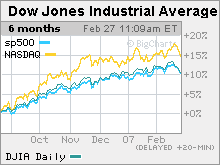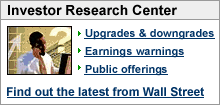After the selloff: Buy, sell or hold?Fears of a slowdown in China and the U.S. spark a selloff. Is this just a correction or a sign of more bad news?NEW YORK (CNNMoney.com) -- Tuesday's selloff on Wall Street on worries about growth at home and abroad, notably China, left investors around the world wondering if this is just a blip or the start of a more prolonged downturn. U.S. stocks tumbled after markets in China, Japan and Europe all plunged. With about an hour left in the session, the Dow industrials sank nearly 500 points, or 3.7 percent before paring some of its losses near the close.
The Dow wound up dropping 416.02 points, or 3.3 percent, its biggest one-day point loss in nearly five and a half years. As the market's losses accelerated, some experts advised investors not to panic. "These things happen. You have to look at days like this as an opportunity. That's our line of thinking," said Ted Parrish, co-manager of the Henssler Equity fund. Parrish said he's thinking of buying more of some of the stocks in his fund that have taken a big hit, particularly in the financial services, healthcare and consumer staples sectors. The S&P 500 tumbled about 3.5 percent and the Nasdaq, which is heavily influenced by technology stocks, skidded 3.9 percent. Brian Stine, investment strategist with Allegiant Asset Management Co., a money management firm based in Cleveland, said a "perfect storm" of bad news triggered the selloff. Shanghai's benchmark index tumbled 8.8 percent Tuesday due to concerns that the Beijing government was looking to crack down on market speculation that has driven Chinese stocks to record highs. Making matters worse for investors, former Federal Reserve Chairman Alan Greenspan said at a speech in Hong Kong Monday that the U.S. economy might slip into a recession by the end of the year. Economic slowdown fears were further fueled by the release of a government report Tuesday morning that showed the biggest monthly drop in new orders for nondefense durable goods, items meant to last three years or more, on record. In addition, a report from the National Association of Realtors indicated that the median price of an existing home fell 3.1 percent in January from a year earlier, giving investors more reasons to worry about the housing slowdown hurting the economy. Finally, increased violence in Iraq and Afghanistan, including a bomb blast at a military base where Vice President Dick Cheney was visiting, also spooked Wall Street. "It's pretty ugly so far," Stine said. "Everything is happening at the same time and that results in this sizable selloff." Still, Stine said that investors should not be too concerned. He downplayed recession fears since it appears that consumer spending has held up relatively well recently. And if anything, Tuesday's sell-off could give the Federal Reserve a reason to lower interest rates soon, said David Chalupnik, head of equities with First American Funds in Minneapolis. Investors typically like rate cuts since they reduce the cost for corporations to borrow money and tend to lead to higher profits. Chalupnik said that the prices of many commodities, including gold and silver, also took a hit on Tuesday. With that in mind, the Fed may have less reason to worry about inflation. "A moderating economy and inflation decelerating is actually good news for the markets. The odds of a Fed rate cut have just increased dramatically," he said. Parrish added that even though the headlines are all proclaiming gloom and doom, he thinks investors do not need to brace for a bear market. "Nothing has changed fundamentally. The market looks attractive but you have some of these negatives hanging over us with housing and China. So obviously some people are spooked. We are just taking a deep breath," Parrish said. Jack Ablin, chief investment officer with Harris Private Bank in Chicago, agreed, saying the fact that durable goods orders were down is a sign of businesses continuing to hold back on capital investments, a development that he said is not new. "Companies have been hoarding their cash. This is a continuation of a long string of disappointments from the corporate side. Businesses are being conservative," he said. At the same time, Stine argued that the market was overdue for a correction. After all, the Dow and S&P 500 have each risen 12 percent in the past six months while the Nasdaq is up 17 percent. However, he added that the market could be in for a couple of rough days, if not longer, before things get better. "The selloff could last for a while because we've had such a big runup over the past few months. This could feed on itself for a few days or few weeks," he said. That could be disconcerting for investors. Although most experts stressed that investors should not bail on solid long-term investments, there's no telling how long Tuesday's market turmoil could last. "It never pays to panic," said Alan Skrainka, chief market strategist with Edward Jones in St. Louis. "Market declines are normal, frequent and not a reason to sell good investments. But they begin and end without warning." Sam Stovall, chief investment strategist with Standard & Poor's Equity Research, added that the market was long overdue for a drop like the one seen Tuesday. "Corrections hurt. But this is not something investors should get too worried about. The market has been in need of a digestion of gains for some time," he said, noting the S&P 500 had not fallen 2 percent in one day before Tuesday since May 19, 2003. "Usually you have big pullbacks at least once, if not several times, during a bull market." Another market strategist agreed, saying that the recent gains in stocks may have been too much, too fast - and that as a result, some stocks may have gotten ahead of themselves. "I have been worried about optimistic valuations for months," said Jeffrey Saut, chief investment strategist for Raymond James. "Stocks are certainly not as expensive as they were at the peak of the bubble in 2000, but they are not cheap. With waning earnings momentum, I'd be pretty cautious here." Saut said earnings growth should slow this year, which could make it tougher for stocks to keep climbing. To that end, earnings for the S&P 500 in the first quarter are expected to increase by just 4.1 percent from a year ago, according to figures from Thomson Financial. That would mark the first time in 14 quarters that earnings failed to increase at a double digit percentage pace. John Butters, a research analyst with Thomson Financial, added that earnings growth for much of the rest of the year is also expected to be relatively sluggish. Profits are expected to increase 4.5 percent in the second quarter and 6.1 percent in the third quarter before returning to double-digit percentage growth in the fourth quarter, with expectations of an 11.8 percent increase. "Since January, we've seen estimates come down quite a bit. There have been pretty significant cuts to the energy sector and, to a lesser extent, consumer discretionary and technology stocks," Butters said. Saut also noted that many stocks that had been leading the market's rally, including Mastercard (Charts), Merrill Lynch (Charts) and Google (Charts), have recently slipped from all-time highs and struggled lately. "More stocks are joining the top-out parade," he said. "We needed a correction." But Harris' Ablin said Tuesday's market slump was probably a good time for investors to add more stocks to their portfolios, since he did not think the sell-off would last that long. "Any pullback will be more of a buying opportunity than an indication of more to come on the downside. Investors are nervous since we haven't seen a meaningful pullback during this rally," he said. "Perhaps this was the catalyst investors needed to pull the trigger." |
|




